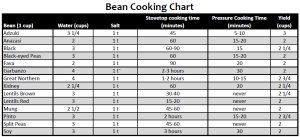by: Carl Haakenstad, Bulk Buyer
Well, ok, I admit that not everybody thinks of dry beans as very exciting, but they have a lot to offer the shopper who is value, health and flavor conscious. Dry beans are a great example of the slow foods to be found in the bulk department because they are a food in their most raw form. This means that you have to plan for their cooking time, but it also means you are starting with a blank food slate that you can spice up in many exciting ways. Since slow foods are close to their original form, it also means that they maintain as much of their original nutrition as possible, which, is great because beans are a good source of protein, dietary fiber, B vitamins, calcium, and iron while also being low in fat. Below are some of the dry beans offered in the bulk department along with their culinary characteristics and some cooking tips.
Bean Cooking Chart (click on the image to make it bigger)
Adzuki Beans: Compact and deep red in color, these beans are native to Japan and are some of the most easily digested of any beans. In the world of macrobiotics, these beans are known as a balancing and strengthening food. They are similar in flavor to kidney beans and can be easily substituted for them. Try serving cooked adzuki beans with quinoa and an Asian dressing of tamari (soy sauce), honey, ginger, and sesame oil.
Black Beans: Also known as “turtle” beans and common in Mexican, Central American and Cuban cuisine. These dark beans stand up to intense seasoning like hot chilies and savory herbs. I like to finish cooking them in a simple sauce of a little tomato paste and broth or water along with plenty of cumin, coriander, paprika, garlic, and cayenne or chipotle. If you want to add an even bolder taste to your sauce, try re-hydrating an Ancho or Chipotle pepper from the bulk Herb and Spice section and use a blender to puree them into the sauce.
Cannellini Beans: These beans are popular in Mediterranean cuisine and are known as white kidney beans. Cannellini beans are a staple in a good minestrone soup, which would also be a great way to use up any extra tomato, basil, and oregano from your garden. They are also great for use in simple bean dips, like the one listed below. You can experiment with other herb and spice combinations in making bean dips because they are simple and quick to make and can be delicious with many different flavor combinations.
Mung Beans: Small and green in color, these beans are popular in Asian and Indian cuisines. They pair well with curries that are full of spices, chilies, and ginger. Additionally, they are quite good when sprouted and added to stir fry.
Soybeans: These beans are native to China and have the most protein of any bean. Soybeans do take longer than other beans to cook but they are very versatile once cooked. Try some in your bean soup recipes or try sprouting some for adding to a stir fry.
Split Peas: Coming in both yellow and green varieties, these beans break down into a hearty mush when cooked thoroughly. Split peas are a perfect bean for soups and stews since they produce a thick consistency
and have a pleasing, savory
flavor. You can try them in Dal, a thick – usually Indian – stew, by cooking them with curry powder, chilies, onions and vegetables. Serve this Dal over rice or quinoa and you will have a healthy, complete meal.
Over the years beans have gotten a, well, stinky reputation because of what they can do to your digestive system. But you should know that if cooked properly beans can be easily digested. One important thing is to make sure you cook your beans thoroughly. If they are still crunchy, they can be very hard to digest.
Here are some more tips to make sure your beans are thoroughly cooked and easily digested:
-Don’t cook the beans in the same water they were soaked in.
-Add Beano to cooked beans
-Add a little vinegar toward the end of cooking. Plus, adding vinegar can make for a wonderful
tangy sauce to go with your cooked beans. Function and flavor all in one.
-Only add salt to beans at the very end of their cooking time. If you add it earlier, it can cause
the bean skins to remain hard and take a long time to cook. Your beans may need salt just
don’t be too hasty with it.
-Pick up a grain and bean cooking chart – part of the How To Shop Bulk tri-fold – at the Co-op
so you know how long to cook your dry beans. These cooking charts are available by the
shopping carts in front and on the bulk counters in the rear.
So now that the weather is cooling off, dust off your stove and cook some dry beans. Whether you are making refried beans or a big batch of bean soup, beans are a great cool weather food because they call for lots of spices and they are cooked into hearty dishes that will stick to your ribs and warm you from the inside. All hail the humble bean. Return to articles
Roasted Red Pepper and Cannellini Bean Dip
www.myrecipes.com
Ingredients:
1/4 cup chopped fresh basil
1 teaspoon balsamic vinegar
2 cups cooked cannellini beans
1 (7-ounce) bottle roasted red bell peppers, rinsed and drained
1 large garlic clove
2 tablespoons extra virgin olive oil
1/2 teaspoon salt
1/2 teaspoon freshly ground black pepper
Directions: Process all of the above ingredients in a food processor or blender while slowly adding the olive oil. Add salt and pepper to taste once everything is mixed. Serve with pita wedges or crackers of your choice.
Split Pea Soup with Gouda-Sausage Toasts
www.epicurious.com
Bon Appetit, Oct 1991
Yield: 6 servings
Ingredients:
1 pound dried green split peas
1 pound fully cooked smoked sausage (such as Kielbasa), split lengthwise
4 14 1/2-ounce cans low-salt chicken broth
2 onions, chopped
3 large celery stalks, chopped
4 large garlic cloves, chopped
2 teaspoons dried thyme, crumbled
1 large bay leaf
1/8 teaspoon ground cloves
2 1/2 cups firmly packed shredded Gouda (about 10 ounces)
Strong German-style mustard
12 1/2-inch-thick slices sourdough baguette, toasted
Directions:
Combine first 9 ingredients in heavy soup pot or Dutch oven. Bring to boil over high heat. Cover pot; reduce heat to low and simmer until peas are tender, stirring occasionally, about 1 hour.
Transfer sausage to large plate; cut into bite-size pieces. Reserve 1/4 of sausage pieces; return remaining sausage to soup. Add 1 cup Gouda to soup and stir until melted. Thin soup to desired consistency with water if necessary. Season with salt and pepper. Keep warm
Preheat broiler. Mix remaining 1 1/2 cups Gouda with reserved sausage pieces. Spread generous amount of mustard on bread slices. Top with Gouda-sausage mixture. Broil until cheese melts and begins to brown. Serve soup, passing toasts separately.




